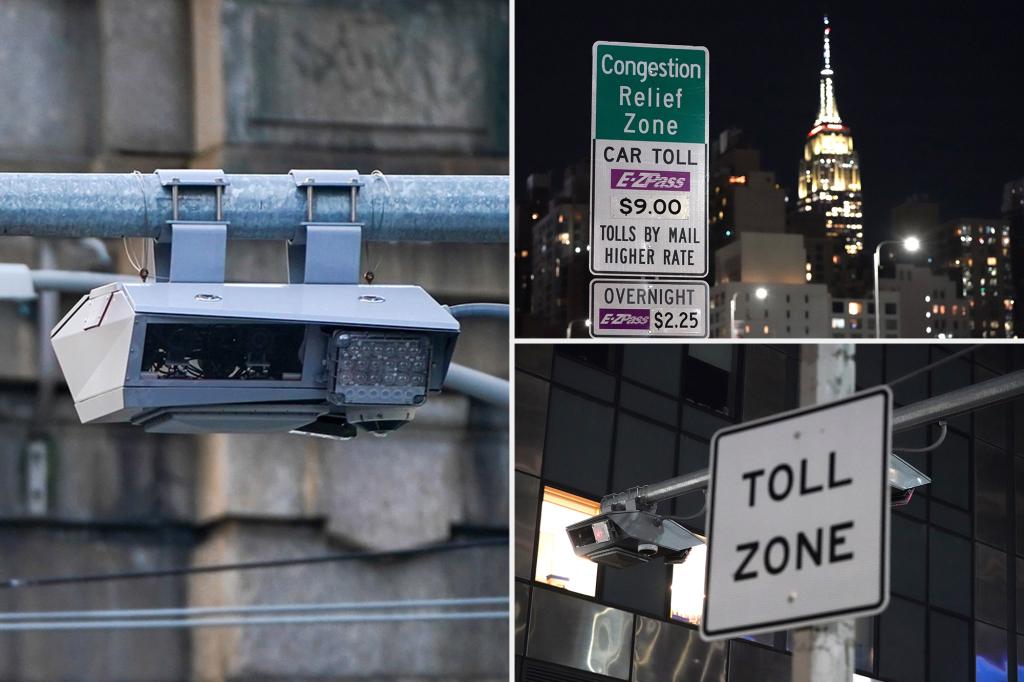The Metropolitan Transportation Authority (MTA) marked the implementation of New York City’s congestion pricing plan with a celebratory unveiling of a new toll sign, just hours before drivers would begin paying the controversial fee. MTA CEO Janno Lieber personally revealed the sign displaying the $9 toll at a lower Manhattan entry point to the Congestion Relief Zone. The event, captured in a video posted on the MTA’s Instagram account, showed a crowd of congestion pricing supporters cheering Lieber as he stood in a crane and unveiled the sign. This seemingly festive atmosphere contrasted sharply with the online reaction, where critics of the toll voiced their disapproval and questioned the celebratory nature of the event. The stark difference in perception highlights the deep divisions surrounding the new pricing scheme and its potential impact on New York City.
The congestion pricing plan, set to take effect at midnight, introduces a variable toll system for vehicles entering Manhattan’s central business district, defined as the area south of 60th Street. Passenger vehicles will be charged $9 during peak hours, defined as 5 a.m. to 9 p.m. on weekdays and 9 a.m. to 9 p.m. on weekends. During off-peak hours, the toll will be $2.25. Commercial vehicles will also be subject to the congestion pricing, with small trucks facing a $14.40 peak hour toll and large trucks a $21.60 peak hour toll. These varying toll rates reflect the MTA’s aim to discourage unnecessary vehicle traffic during the busiest times, while still allowing access to the central business district.
The online backlash to the MTA’s celebratory unveiling of the toll sign underscores the significant opposition to the congestion pricing plan. Critics of the plan argue that it disproportionately affects lower and middle-income drivers who may not have alternative transportation options. They also express concern about the potential for increased traffic in surrounding areas as drivers seek to avoid the toll zone. Furthermore, some question the effectiveness of the plan in achieving its stated goals of reducing congestion and improving air quality, while others raise concerns about the transparency and accountability of the MTA in managing the collected toll revenue. These concerns, amplified by the online criticism of the MTA’s celebratory event, frame the congestion pricing plan as a contentious issue with significant implications for New York City’s transportation landscape.
The implementation of congestion pricing marks a significant milestone for New York City, making it the first city in the United States to adopt such a comprehensive system. Proponents of the plan argue that it is a necessary step to address the city’s chronic traffic congestion, which contributes to air pollution, lost productivity, and diminished quality of life. They highlight the potential for the toll revenue to fund much-needed improvements to the city’s public transportation system, thereby encouraging greater use of mass transit and further reducing reliance on private vehicles. Moreover, they point to the potential environmental benefits, such as reduced greenhouse gas emissions and improved air quality, as key advantages of the plan. The contrasting perspectives on the congestion pricing plan highlight the complex trade-offs involved in addressing urban mobility challenges.
The MTA’s projection of $1 billion in annual revenue from congestion pricing is a crucial element in its plans to modernize and expand the city’s aging subway and bus systems. This influx of funds is expected to finance critical infrastructure projects, including signal upgrades, new train cars, and accessibility improvements. These investments are seen as crucial for improving the reliability and efficiency of the public transportation system, ultimately making it a more attractive alternative to private vehicles. The success of the congestion pricing plan, therefore, hinges not only on its ability to reduce traffic congestion but also on the MTA’s ability to effectively utilize the generated revenue to enhance the public transportation system. The public’s perception of how this revenue is managed will significantly influence the long-term acceptance and effectiveness of the congestion pricing plan.
The introduction of congestion pricing in New York City represents a bold experiment in urban transportation management. Its success will depend on a variety of factors, including the actual reduction in traffic congestion, the effective reinvestment of toll revenue in public transportation, and the overall impact on the city’s economy and environment. The ongoing debate surrounding the plan reflects the diverse perspectives and concerns within the city, highlighting the complex challenges of implementing large-scale transportation policy changes. The long-term consequences of congestion pricing will unfold over time, providing valuable insights into the effectiveness of such policies in addressing urban mobility challenges and shaping the future of transportation in other major cities around the world.

